Wideband Realities: The Truth About Oxygen Sensors’ Limitations
This is not a story on trashing oxygen (O2) sensors even though the title might appear to make that implication. Instead, we thought we’d share some insight into how O2 sensors work and how they might conspire – unintentionally – to fool you. So as not be deceived, it’s necessary to learn how O2 sensors operate.
The most important point is that O2 sensors do not measure air-fuel ratio. As their name implies, oxygen sensors measure the presence of oxygen in the exhaust. Once measured, the system’s ECU and software compute the relationship of oxygen to fuel based on a given fuel’s stoichiometric ratio. Once that ratio is calculated, the meter displays that information as an air-fuel ratio (AFR).
Because O2 sensors use free oxygen as their only measurement for calculating AFR, they can be subject to significant error when working at idle on engines equipped with long duration camshafts and/or cams with excessive overlap.
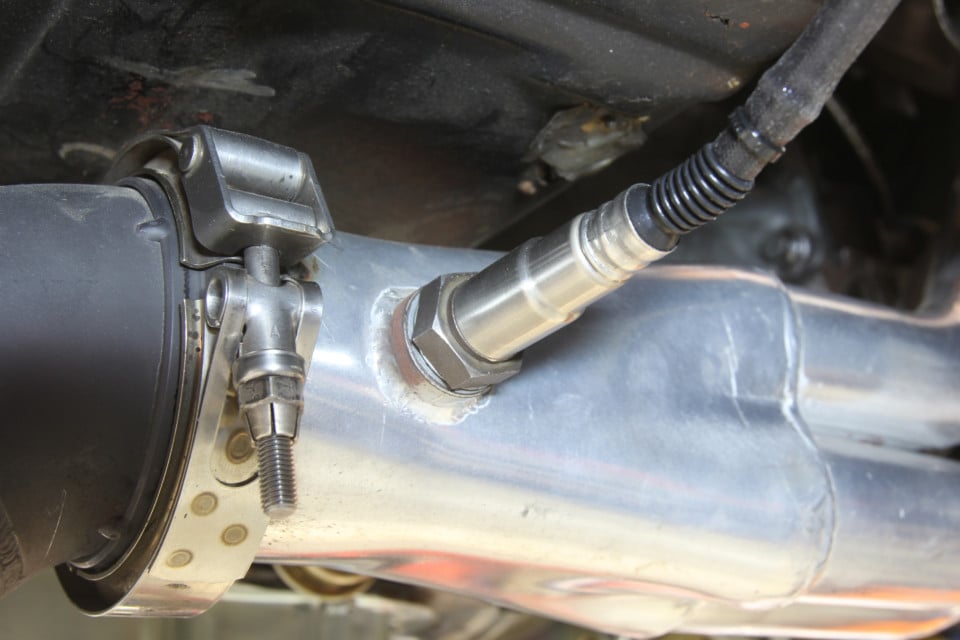
Adding an oxygen sensor to the exhaust is a great tuning aid if it is used properly. However, it isn’t a magic cure-all and you need to understand how the sensor works to truly get the most benefit out of one.
Idle Hands Make the Devil’s Work
Overlap is defined as the amount of time (in crankshaft degrees) that both the intake and exhaust valves are open simultaneously. Overlap is what creates that desirable lumpy idle for street engines. The problem occurs when an excessive amount of oxygen makes its way from the intake port directly into the exhaust at idle and low engine speeds because of overlap. This free oxygen is picked up by the O2 sensor and determined to be indicative of a lean AFR condition when, in reality, the engine could potentially be running slightly rich.
As an example, we have some experience with a carbureted 4.8L LS engine in a street Chevelle. Even though the engine is equipped with a conservative 219 degrees of duration at 0.050 in its hydraulic roller cam, the tight converter created a sufficient load to pull the idle speed down when in gear to around 750 rpm. Despite the cam’s mild overlap, the on-board wide-band sensor produced readings of between 16:1 and 17:1 AFR on our wideband O2 sensor.
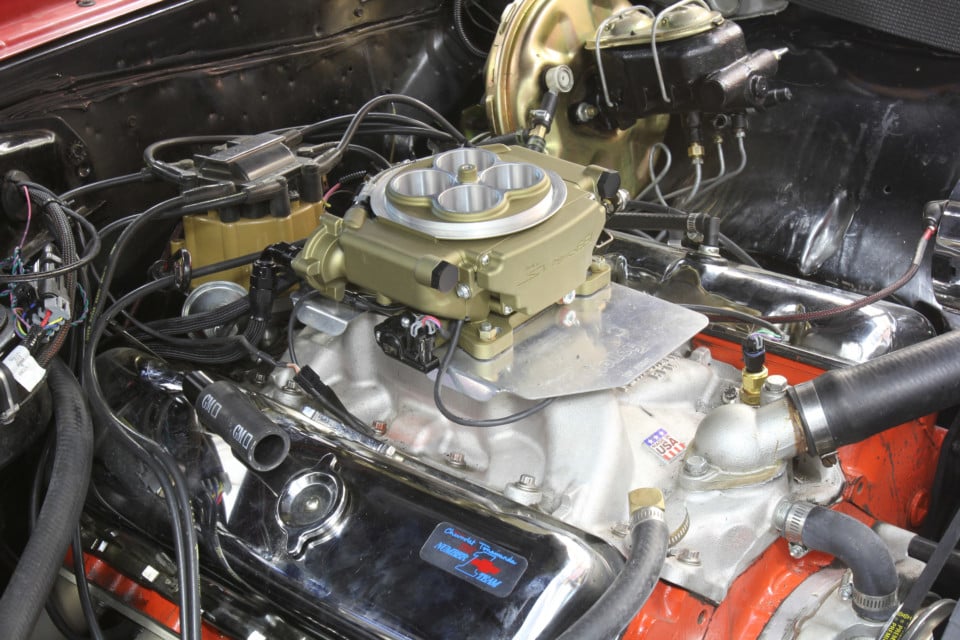
This is the Sniper unit on a big-block Chevrolet. To prevent “learning” that could cause the trim tables to go excessively rich, we ran the engine for a few hours to establish a decent tune that ran well. Then we turned the Sniper’s learning function off to prevent the system from over-compensating for free oxygen in the exhaust from camshaft overlap.
We knew from experience that this engine would not idle at a true 16:1, so this was clearly an error produced by the overlap in the camshaft. This only occurred at idle. As soon as RPM increased to over 1,000, the AFR readings became increasingly richer and more accurate. This makes relying on the O2 sensor problematic for engines with long duration and high overlap camshafts at idle. This is also why “self-learning” throttle body EFI systems tend to struggle when used on engines with lower than 10 inches of manifold vacuum. The excess oxygen “fools” the self-learning system into tuning for a rich AFR. Let’s look at why this occurs.
Let’s assume we have an engine that is equipped with self-learning throttle body EFI but is also equipped a long-duration camshaft that idles at 9 inches of manifold vacuum. The owner commands a target idle AFR of 13.5:1. This is one point that the EFI system will use to calculate the amount of fuel to deliver to the engine. Engine displacement, idle speed, and manifold vacuum are also integrated into the equation used to produce an idle fuel number.
With excess free oxygen in the exhaust, the O2 sensor reads this as a too-lean condition, so the ECU adds fuel. Then when the engine is shut off, most of the self-learning systems add this fuel to the long-term fuel trim number – richening the overall fuel delivered at idle. When the engine is started again, the whole process repeats. After about 15-30 restarts, the engine is now running excessively rich and yet the O2 sensor still detects free oxygen present in the exhaust. The owner is frustrated because the engine is running way too rich, fouling plugs, and generally runs poorly.
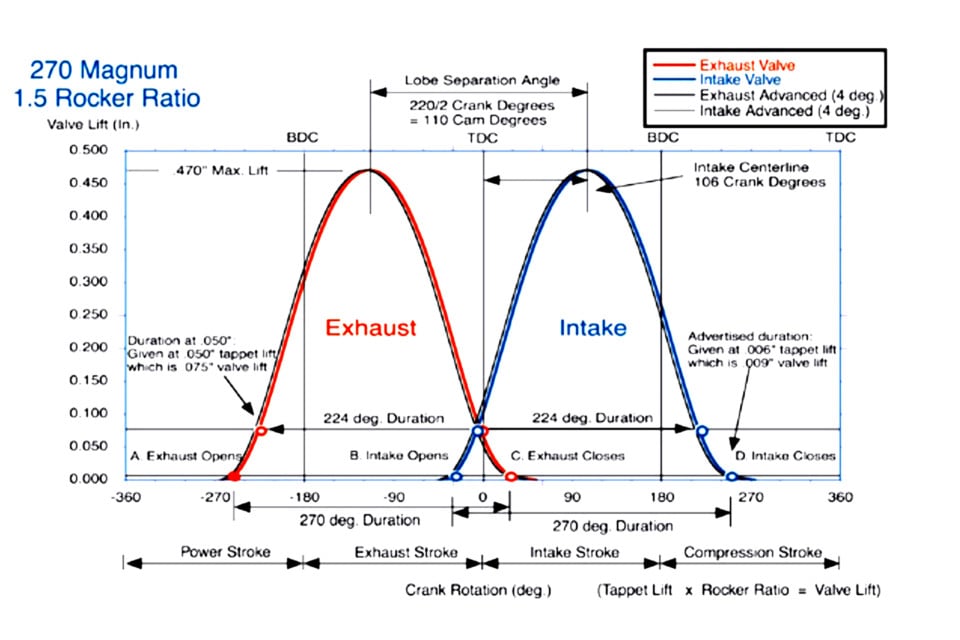
This Comp Cams drawing reveals the relationship of exhaust closing and intake opening to overlap. As overlap increases, that little triangle becomes larger, which will allow more free oxygen into the exhaust and fool the O2 sensor at idle.
How to Calculate Overlap
This will compare the overlap of two camshafts. Most cam cards will deliver all the information you need. For this example, we’ll look at overlap on two Comp small-block Chevy hydraulic roller cams. The most accurate way is to use advertised duration numbers which for these cams is at 0.006-inch tappet lift. The formula is very simple. Merely add the exhaust closing to the intake opening number to determine overlap.
Cam A
268XFI
268/276 Degrees Advertised Duration (at 0.006-inch tappet lift)
218 / 224 at 0.050 with 113 degree LSA and 109 degree intake centerline
Int. Open 25 BTDC Exh. Close 21 ATDC = 46 degrees of overlap
A 350ci small-block Chevy with this cam idled at 14 InHg of manifold vacuum at 850 rpm.
Cam B
XR294HR
294/300 Advertised Duration
242/248 at 0.050 with 110 degree LSA and 110 degree intake centerline
Int. Open 41 BTDC Exh. Close 36 ATDC = 77 degrees of overlap
(77 – 46 = 31 degrees difference in overlap between Cam A and Cam B)
A 383ci small-block Chevy with this cam idled at 9.5 InHg of manifold vacuum at 950 rpm.
Comparing the idle vacuum between these engines is a direct reflection of the effect of overlap on idle quality. This is also why stock GM LS camshafts use an LSA between 116 and 122 degrees – to smooth the idle and help the O2 sensor.
Just for fun, we calculated the overlap numbers for the largest Comp Mutha Thumpr cam which came to 88 degrees! Compared to Cam A, that’s an overlap increase of 42 degrees!
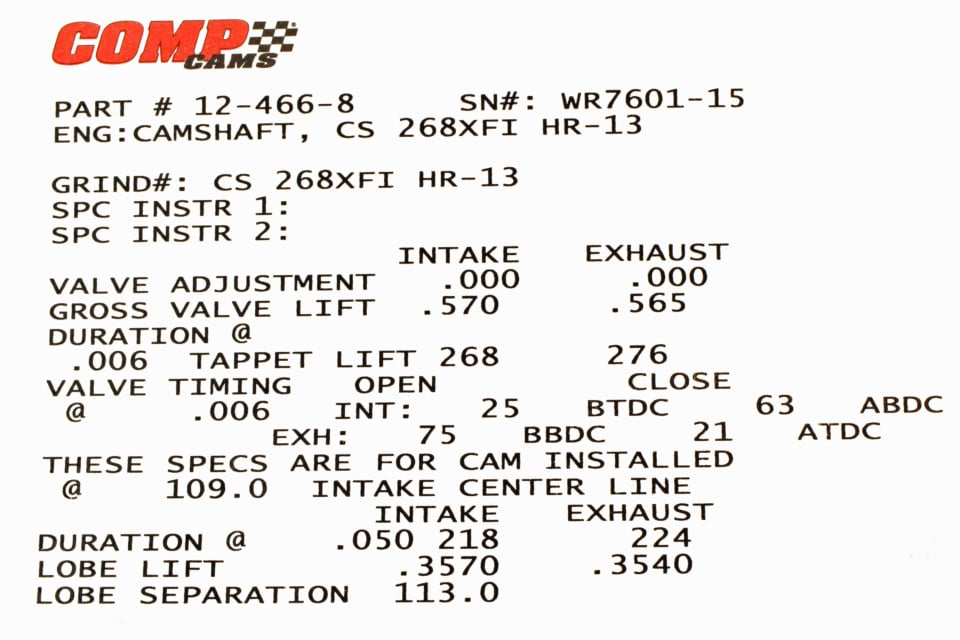
To calculate the overlap on your camshaft, find the exhaust opening and intake closing points – preferably at the advertised numbers. We’re using a Comp Cams card that lists opening closing points at 0.006-inch. Look for Valve Timing at .006 and then find the Intake Opening (25 BTDC) and Exhaust Closing (21 ATDC) numbers. Add these two numbers together (46 degrees) and you have valve overlap at 0.006-inch of tappet lift.
Fooling the Brain
One solution to this issue is to make sure there are no leaks in the system that could contribute to this problem. Even a small exhaust leak will pull fresh air in from the outside and greatly exacerbate this free oxygen problem. The next step is to start over by re-booting the system, establish a decent running AFR where the engine runs cleanly at idle (regardless of what the O2 sensor reads) and then disable the learning function at idle so further corrections do not continually add fuel to the system. This isn’t as dramatic as it sounds, since a majority of learning with these systems is accomplished within the first hour of driving the engine in various situations.
This problem with high overlap camshafts and O2 sensors isn’t limited to just EFI engines. Carbureted engines can suffer problems as well. Engine builders and tuners all agree that when evaluating a tuning routine – it’s always recommended to adjust air-fuel ratio and timing for what the engine wants, not necessarily toward a specific number. This means if you change the idle fuel or ignition timing – listen to the engine.
If it sounds better, the vacuum gauge reads a higher and more stable number, and the idle speed increases, all of these are indications the engine liked the change. When these things occur, the engine is telling you that this was a good step – regardless of the number displayed on the AFR device. Another way to put this is to not chase after a magic AFR number that you think the engine should achieve. The engine will tell you what it prefers if you pay attention.
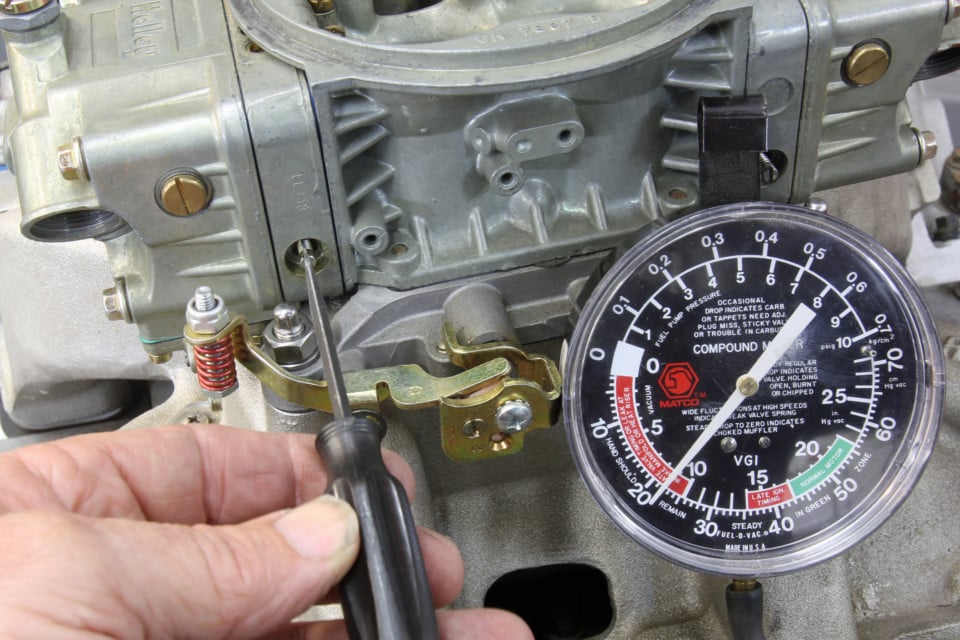
The old school way of tuning carburetors with a tach and a vacuum gauge may be crude, but will also get you close especially on engines with big cams. As you can see, this engine is idling at barely 9 inches of manifold vacuum (inner scale), so if we had an O2 sensor reading, it would probably indicate much leaner than the engine’s actual AFR.
A Computer Isn’t A Substitute For Your Brain
This doesn’t mean we cannot use high-tech devices to help us with the tuning effort. We recently installed a Holley Sniper system on a big-block Chevrolet. With the engine warmed and idling, the default idle AFR was 13.8:1.The engine idled decently and sounded good. We then installed an EMS five-gas exhaust analyzer to evaluate the idle quality. The machine indicated very high HC (unburned hydrocarbons – raw fuel).
A high HC number could mean that the AFR is excessively rich. But it could also indicate a misfire because the engine was running lean. The engine was equipped with a relatively mild hydraulic roller camshaft that did have some overlap. We commanded a 13.2:1 AFR and the HC count dropped, revealing that the engine wanted the extra fuel to idle more efficiently.
This is where a preconceived notion that the engine should run at 13.8:1 would not necessarily be what was best for the engine. Admittedly, the HC difference was minor, but the point is that when we richened the idle AFR, idle vacuum also increased about 0.5 InHg. The bottom line was that the engine wanted more fuel at idle.
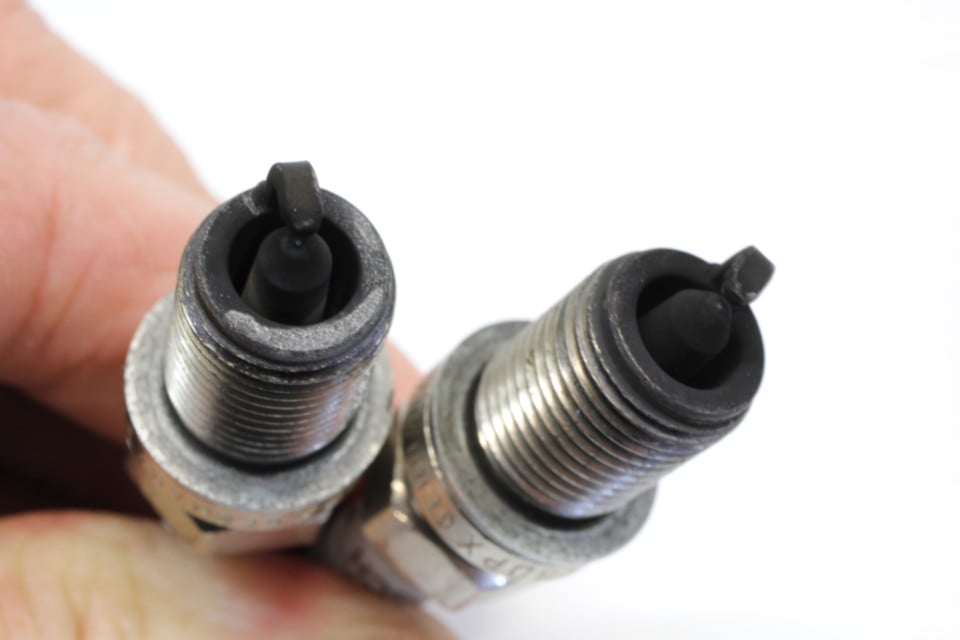
If you’re not sure if your O2 sensor is accurate with a big-cam engine, you can always pull a spark plug and look at it. If it looks like this, the engine is definitely too rich. In this case, a big cam in the engine was fooling the O2 sensor and the tuner thought the engine was too lean!
Please don’t interpret this to mean that you should not use an O2 sensor to help tune. Instead, it’s a matter of understanding what is really happening inside the engine. Once an engine reaches a certain engine speed – 2,500 rpm as an example – the issue of overlap isn’t as critical because there’s less time for this to occur. This will make the O2 sensor readings far more accurate.
Accuracy vs. Precision – The Eternal Struggle
“Accuracy” is a relative term, even here, because of how the O2 sensors are designed. As we mentioned earlier, O2 sensors use free oxygen as the basis for a calculation of an AFR. We won’t get into all the details of how this calculation occurs but each manufacturer uses a different smoothing process to record this data and determine the AFR. This is one reason why comparisons of several O2 sensors from different companies in the same exhaust system will display different results. If an O2 sensor is used as a comparator on a given engine, then its accuracy isn’t as critical.
As an example, let’s say we have a big-block Chevy on the dyno and the O2 sensor tells us the AFR is 12.8:1. This may or may not be an ideal ratio for that engine and that number may or may not be 100 percent accurate. What is important is that we’re using it as a reference point from which we can evaluate a change. Assuming we added 2 jet sizes, the AFR changed to 12.4:1, and the power dropped 6 hp, we know we’ve increased fuel and the engine responded by losing power. The indicated AFR number is a reference point.
What we know is that the indicated 12.4:1 is too rich. So we then changed jetting to two jet sizes leaner than the original jetting. This test revealed that the AFR moved to 13.2:1 and power was down from the baseline but only slightly. Some tuners may then say – that engine wants a 12.9:1 AFR. Our version is that with that particular O2 sensor that might be a correct statement. But what we would suggest is that the engine is now very close to best peak power under the current atmospheric conditions. The tuner could then use 13.0:1 as a point of reference.
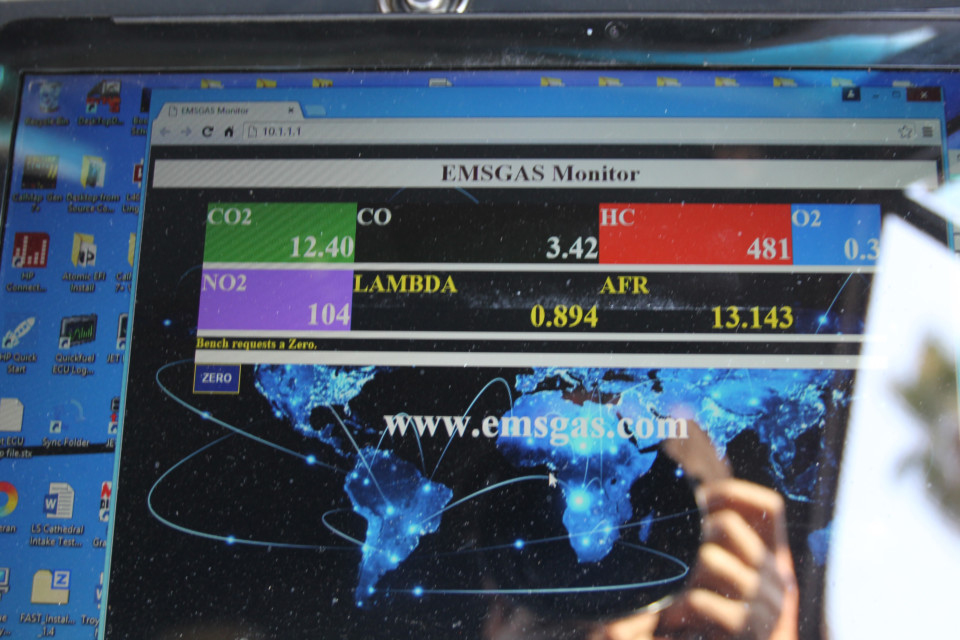
This is a display of EMS’s 5-gas analyzer on that big-block El Camino. This is a photo of the screen as the car was running 65 mph on the highway in overdrive. The CO2 is 12.4-percent, CO is 3.42-percent, HC is 481 ppm, O2 is 0.3-percent, NO2 (NOx) is 105 ppm and the AFR is 13.14:1. There is very little free oxygen at 2,000 rpm and the calculated AFR reveals that it might be running slightly rich. The next step would be to try leaning the AFR slightly to improve the fuel mileage as long as the CO2 does not drop.
All wideband O2 sensors calculate an AFR based on a known standard, which is called the fuel’s stoichiometric air-fuel ratio. For pure gasoline, this is 14.7:1. But right away it’s important to mention that nearly all pump gasoline sold in this country is laced with 10-percent ethanol. This may not sound like a big deal, but it changes the fuel’s stoichiometric number from 14.7:1 to 14.1:1.
Here’s why this is important. Since nearly all wideband oxygen sensors uses 14.7:1 as the baseline from which to calculate the actual air-fuel ratio, right from the beginning the O2 sensor’s display is off by roughly half a ratio. Let’s confuse this situation further by adding that any oxygenated race gasoline will likely spec a different stoichiometric AFR.
To underscore this point, VP Racing Fuels‘ Q16 sports a stoichiometric ratio of 13.3:1. That’s a 1.4:1 or a 10-percent shift from 14.7:1. If you think this will create a significant AFR “error” on a wideband O2 sensor, you would be correct. Racers will tell you “Yeah, Q16 always reads rich.” Now you know why.
We’ve touched on several areas on how to keep track of not only what your O2 sensor is telling you but how to interpret those numbers so you don’t get lost or confused. Just remember to use that wideband gauge as a comparator. Being a sharp tuner means understanding how all the systems work and then using that information to make intelligent decisions. Your engine will thank you.
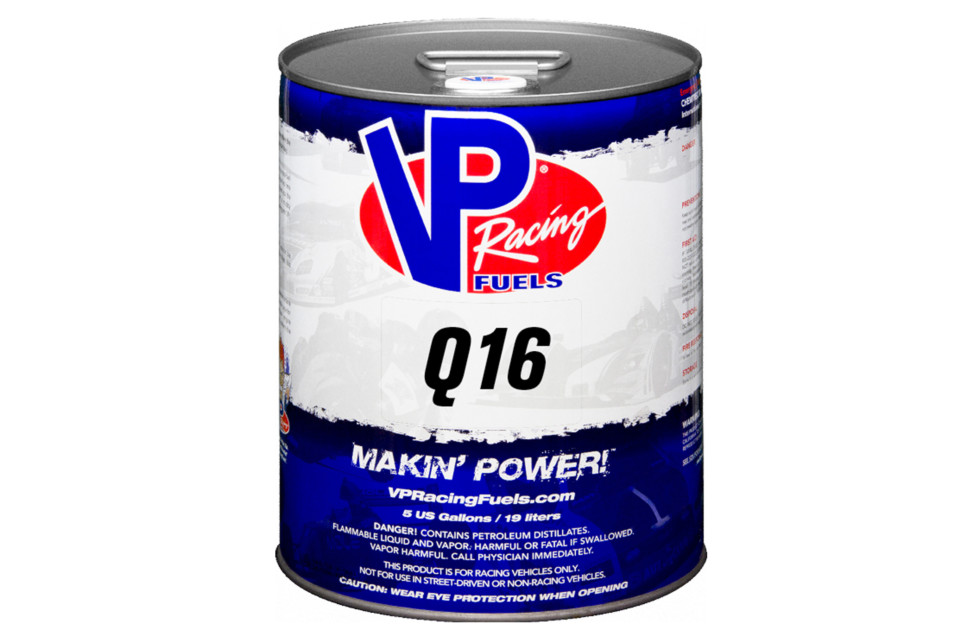
VP’s Q16 racing gasoline is a highly oxygenated example of a fuel that is a long way from a stoichiometric AFR of 14.7. VP rates this fuel with a stoichiometric ratio of 13.3:1 and suggests increasing carburetor jetting by 4- to 6-percent to compensate for the added aromatics. The point is that not all “gasoline” has a stoich of 14.7:1.

